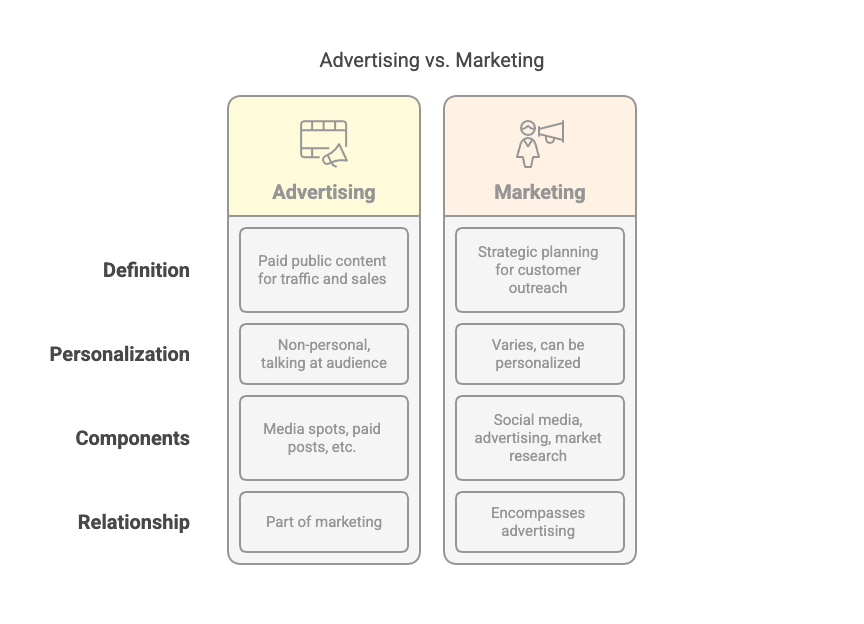A lot of people use the terms ‘marketing’ and ‘advertising’ interchangeably. That’s understandable, to some extent. On the surface, marketing and advertising appear much the same.
They both involve communication between a business and its customer base. About generating brand awareness. About crafting a persuasive message that will ultimately result in conversions.
It’s only when you look a little deeper that differences start to emerge. And believe me, they are significant. We’ll start with advertising, because it’s actually the easiest of the two to describe.
What Is Advertising?
Advertising is paid-for, public content designed to draw in traffic and generate sales. It can take many forms.
- Sponsored search engine results content
- Paid posts or sidebar ads on Facebook
- In-app ads on mobile devices
- Print or direct mail advertisements
- Television, radio, or media spots
Though it’s often targeted by demographic, it is by its very nature non-personal. You’re not speaking to your audience, you’re talking at them. Still, an effectively-targeted or well-designed advertisement can generate a great deal of positive publicity.
Just look at the campaign Old Spice ran back in 2010 “The Man Your Man Could Smell Like.” Featuring a series of hilarious TV spots starring Isaiah Mustafa (and later a face-off between Mustafa and another former spokesman, Fabio), it generated an incredible amount of awareness and goodwill for the brand. Even today, it’s arguably a perfect example of how to do advertising right.
Because it’s very easy to do it wrong. There’s no shortage of horrible, intrusive, creepy, or just downright off-putting ads out there. It’s given advertising – especially online advertising – an extremely negative reputation.
And it’s not getting better.
“Consumers don’t hate ads,” explains Video Design’s Lauren Nettles, “They hate bad ads…People feel overwhelmed, interrupted, and stalked by bad digital ads, but they don’t really mind the good ones.”
We’ll talk a bit about how you can be better at advertising later on in the article. For now, however, let’s touch on the marketing angle.

What Is Marketing?
Here’s where it gets confusing. See, the main reason so many people confuse marketing and advertising is that advertising is actually part of marketing. In other words, all advertising is marketing, but not all marketing is advertising.
Put another way, marketing is the engine that drives all advertising. It’s the strategic, systematic planning process that serves as a foundation for all of a brand’s customer outreach efforts. It encompasses the following components.
- Social media presence
- Advertising
- Unique selling proposition
- Values and goals
- Web presence
- Community relations
- Market research
- Media and ad planning
In other words, marketing isn’t really any individual process or pursuit. Rather, it’s the sum of its parts, a conglomerate of how a brand interacts with both its audience and its competition. When measured against advertising, marketing is geared more towards long-term, strategic planning than immediate returns.
An ad campaign might be established with the goal of promoting the sale of a specific product or service. That campaign might be part of a larger marketing push to change the public’s perception of the brand. The two ultimately serve the same goal, yet the former is more immediate than the latter.
Being Better: Acing The Intersect Between Marketing And Advertising
Right. Now that we’ve gone over the difference between marketing and advertising, let’s talk a bit about how you can do both of them better.
How exactly do you ensure your tactics don’t contribute to advertising’s public image problem? How do you ensure your marketing draws in prospective customers rather than alienating and frustrating them? In broad strokes, by being respectful.
Understand what separates a bad advertisement from a good one. Understand how modern consumers want to be treated, and what sort of behavior turns them away.
Avoid using intrusive ad techniques
Let’s talk about pop up ads – namely, why they should be left to die in the 90s, which is the last time they were relevant.
Sure, there’s a chance someone might see a popup and find it interesting. But there’s a far greater chance they’ll close out of the site they’re on in frustration. Popup ads simply aren’t worth it for the amount of frustration they’ll create in your audience.
By that same vein, obnoxious or resource-heavy ads are also incredibly bad form. As a general rule, if an ad would interrupt a user’s browsing experience, don’t use it. If someone’s interested in your products, you don’t need to be irritating or overbearing to sell them on it.
Be authentic and engaged
It doesn’t matter who your demographic is – today’s consumers appreciate honesty and integrity above all else. If a brand displays neither, they’ll remember, and make a point of choosing the competition.
This applies to your ads as much as it does your marketing tactics. When interacting with your audience on social, treat them like people rather than leads. Generate a personality for your brand that aligns with your business’s core values, and endeavor not to deviate from that.
Be active. Be passionate. Show your audience that there are real, passionate people behind your business rather than faceless marketing mooks.
Your customers will remember that behavior, and respond in kind.
Stay away from auto-play
Imagine, if you would, you’re sitting in the library reading a particularly enthralling book. Then some obnoxious idiot walks up and starts screaming in your ear. Frustrating, right?
That’s what it feels like to have a video start playing when you navigate to a page. Auto-playing video, whether it’s an ad or on-site content, is one of the most terrible design choices on the modern web. If you knowingly use it, your website is bad and you should feel bad.
Don’t treat customers as a captive audience
Commercials are an important part of cable television. I’d even go so far as to say they’re necessary. Not only can they provide as much entertainment as the show itself, their existence has for the longest time allowed people to take a breather from what they’re watching – to get a drink of water, to go to the bathroom, or just to stretch their legs.
Unfortunately, it seemed like a lot of brands looked at digital media like YouTube and concluded that it’s basically the same as television. That’s the only logic I can conceive of that would make anyone think unskippable video ads are a good idea. Because they aren’t.
You’re forcing someone to sit through an ad before they can see the content they’re actually trying to view. You’re wasting their time and frustrating them. No matter how good your ad is, they’re going to associate that frustration with your brand.
Be respectful
If there’s one piece of advice you take away from all this, it should be to treat your audience with respect. This holds true in both marketing and advertising. Never assume you have to dumb things down for your audience.
The idea that you should cater to the lowest common denominator is both harmful and insulting to your audience. In most cases, your customers are much more intelligent than you give them credit for. Treat them as such.
If your market research shows people don’t understand your ads, that’s a problem. It might be with your buyer personas, not your audience.
A good guideline is to think about how you would want to be treated. Would a particular behavior or attitude frustrate you if you as a customer? If so, you should stop doing that.
Don’t be creepy
Privacy is at the forefront of everyone’s minds these days. And why shouldn’t it be? We’re living in an era where data breaches and privacy scandals happen with the same frequency as the sunrise.
An age where the ‘big five’ tech companies know literally everything about us.
Not surprisingly, consumers these days are hyper-sensitive to tactics that leverage their personal information. They don’t like feeling as though your business is stalking them. When it comes to targeting them based on behavior or demographic data, you need to be extremely cautious.
Lauren Nettles has some good advice
If you’d not do it in person, don’t do it online. Pretty simple, right?
“Let’s say a customer is browsing in your store and you see her pick up a pair of sunglasses,” she writes. “You might walk over to tell her that they’re on sale, or that you have another color in the back, or to share a cool story about the brand—each of those interactions add something for her, and she might even welcome them. But if you follow her around the store going ‘did you forget those sunglasses? Are you sure you don’t want those sunglasses? What about now?’ You’re going to lose a customer.”
Another good rule of thumb is that the more relevant you can make a personalized or targeted ad, the better. To that end, research is your best friend here. It might seem strange, but the more you know your audience, the better. You’ll be able to adjust their brand experience more effectively. And you won’t seem like a creepy stalker.
One last thing – make sure you establish your commitment to keeping customer data safe. Take steps to adhere to regulations like Europe’s GDPR, and ask for consent whenever you’re collecting personal data. It might seem like a whole lot of unnecessary busywork, but it matters more than you’d think.
Part of a Unified Whole
It’s easy to see why people so often misconstrue advertising and marketing as being one and the same. There are a lot of similarities between the two. And at the end of the day, you really can’t have one without the other.
Without a marketing campaign as a foundation, advertising efforts will fall flat. Without advertising, a marketing campaign won’t have a great deal of reach or success. To truly succeed in the world of modern business, you need a little bit of both.




